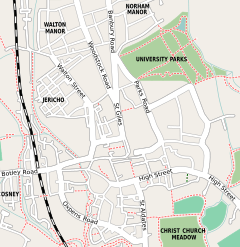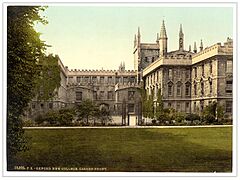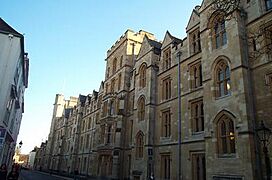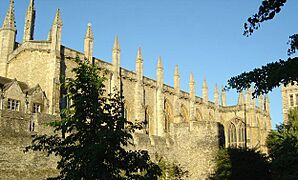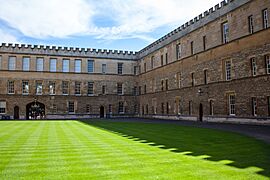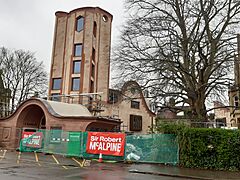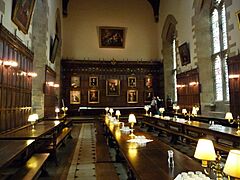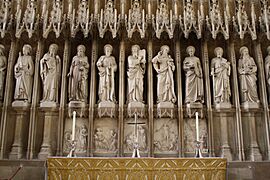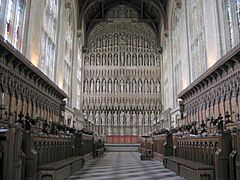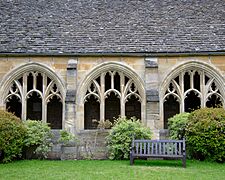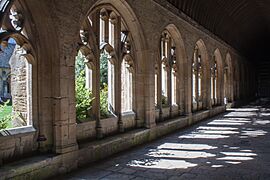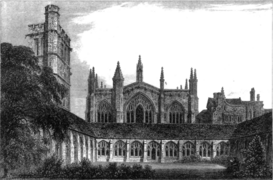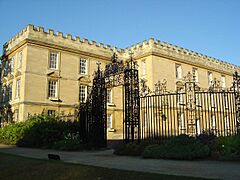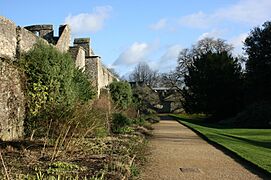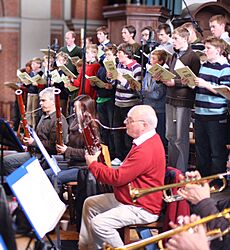New College, Oxford facts for kids
Quick facts for kids New College |
||||||
|---|---|---|---|---|---|---|
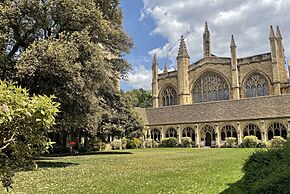
The chapel and the cloisters
|
||||||
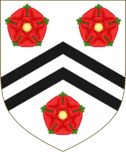
Blazon: Arms of New College Oxford (arms of William of Wykeham): Argent, two chevronels sable between three roses gules barbed and seeded proper.
|
||||||
|
|
||||||
| University | University of Oxford | |||||
| Location | Holywell Street and New College Lane | |||||
| Coordinates | 51°45′15″N 1°15′05″W / 51.754277°N 1.251288°W | |||||
| Full name | St Mary's College of Winchester in Oxford | |||||
| Latin name | Collegium Novum/ Collegium Beatae Mariae Wynton in Oxon | |||||
| Motto | Manners Makyth Man | |||||
| Founder | William of Wykeham | |||||
| Established | 1379 | |||||
| Named for | St. Mary | |||||
| Sister colleges | Winchester College and King's College, Cambridge | |||||
| Warden | Miles Young | |||||
| Undergraduates | 430 (2023) | |||||
| Postgraduates | 360 | |||||
| Major events | Commemoration ball | |||||
| Grace | Benedictus benedicat. May the Blessed One give a blessing Benedicto benedicatur. Let praise be given to the Blessed One | |||||
| Map | ||||||
New College is a famous part of the University of Oxford in the United Kingdom. It was started in 1379 by a bishop named William of Wykeham. He also founded Winchester College as a special school that would send students to New College.
New College was one of the first colleges at Oxford to welcome and teach younger students. It is located in the middle of Oxford, near Holywell Street and New College Lane. This lane is known for Oxford's Bridge of Sighs. New College has a "sister college" called King's College, Cambridge. The college's choir is very well-known and has won awards for its music.
Contents
History of New College
Even though it's called "New College," it's actually one of the oldest colleges at Oxford! It was founded in 1379 by William of Wykeham, who was the Bishop of Winchester. He named it "Saint Mary College of Winchester in Oxenford." People started calling it "New College" because there was already another college in Oxford named after St Mary (Oriel College).
How New College Was Started
In 1379, William of Wykeham decided to create a new college. He asked King Richard II for permission to build it. He also wrote his own rules, saying the college should have a leader (called a warden) and seventy scholars. He bought the land from the City of Oxford and other colleges. This area used to be a dangerous ditch near the city wall. It had even been used for burials during the Black Death.
The college was founded at the same time as a special school, Winchester College. Winchester College opened in 1394. Both places were designed by the same master builder, William Wynford. The first stone of New College was laid on March 5, 1380. The college buildings were ready by April 14, 1386.
William of Wykeham also created the college's motto, which is "Manners Makyth Man." This means that good manners and character are what make a person truly great. The college's coat of arms, which is also William of Wykeham's, shows two black V-shapes (called chevrons) and three red roses.
New College was set up so that prayers could be said for William of Wykeham. He wanted the college to have ten chaplains, three clerks, and a choir of 16 young singers.
New College was special because it was one of the first Oxford colleges to accept younger students. It was also the first in Oxford to be planned around a main square courtyard, called a quadrangle. The college was as big as all the other six Oxford colleges put together at the time!
New College During Wars
During the English Civil War, the Royalist soldiers used the college's cloisters and bell tower to store weapons. Later, in 1651, Parliamentarian forces made the college stronger for defense. In 1685, during Monmouth's rebellion, a college member named Robert Sewster led a group of student volunteers, many from New College. They practiced their drills on the college's bowling green.
Learning at New College
For a long time, until 1834, students at New College didn't have to take the main university exams for their degrees. They only had to pass the college's own tests.
Like many Oxford colleges, New College welcomed its first female students in 1979. Before that, for six centuries, it was only for men.
In 2022, New College students did very well in the Norrington Table, which ranks how well Oxford colleges perform academically. They scored 75.5. In 2020, they had the highest score of 83.5.
The young singers (choristers) used to live inside the college. But as the school grew, they moved to New College School in 1903.
College Connections
King Henry VI was very impressed by William of Wykeham's idea of having two linked institutions (New College and Winchester College). He decided to create his own similar colleges: King's College, Cambridge and Eton College.
Since the mid-1400s, New College and Winchester College have been formally linked with Eton College and King's College, Cambridge. This four-way friendship is known as the Amicabilis Concordia. King's College and New College are considered "sister colleges."
Buildings and Gardens
When New College was first built, it was a grand example of the "perpendicular style" of architecture. Over the years, the college has added many new parts to its original quadrangle. The top floor of the main quad was added in the 1500s. In 1674, it was replaced with the third floor you see today. The oval grassy area in the middle of the quad was added in the 1700s.
Many of the college's buildings are considered very important for their architecture or history.
The first buildings included the Great Quad with its Gate Tower, the dining hall, the chapel, and the cloisters. The cloisters were used as a burial site starting in 1400. There was also a bell tower built in 1400. Other early buildings included the Warden's Barn and the Long Room.
Later, the three-sided Garden Quadrangle was completed between 1682 and 1707. More buildings were added in the 1800s, forming the Holywell Quad. A set of buildings called 'New Buildings' were constructed along Holywell Street between 1872 and 1896.
New College has also built new student housing on its Savile Road site, next to New College School. These new buildings, called the Gradel Quadrangles, were designed by David Kohn Architects. They were approved in 2018 and provide 99 new student rooms. They also have more dining and kitchen space, a flexible learning area, and a place for performances.
The tower of the Gradel Quadrangles has cool carved animal figures. These carvings represent endangered species. Other animal carvings on the walls show a modern focus on protecting the environment. The diamond-shaped windows on the upper floors are a nod to a famous building in Moscow. Construction on these buildings was completed in 2024.
The Dining Hall
The hall is where students and staff eat their meals. It is very large, about 80 feet long and 40 feet wide. William of Wykeham made rules that no noisy games like wrestling or dancing were allowed in the hall. This was because the chapel and living areas were very close by. He also said that people should speak Latin during meals!
The wooden panels on the walls were added a long time ago. The floor was paved with marble in 1722. The original open oak roof was replaced with a ceiling by the late 1700s. In 1865, the roof was restored to its current look. The plain windows were replaced with stained glass, and the portraits were moved. The hall was also fully restored in 2015.
Chapel and Cloisters
The college chapel was designed similarly to Merton Chapel. It has a screen that separates the main chapel from the front area, called the ante-chapel. After the Reformation, some changes were made inside, like removing extra altars and covering the statues.
Much of the old stained glass in the ante-chapel has been carefully restored. This project took 20 years! The chapel also has a statue of Lazarus by Sir Jacob Epstein and a painting by El Greco. Some of the stained glass windows, including the large Great West Window, were designed by the famous artist Sir Joshua Reynolds.
-
Painting of St James the Greater by El Greco, around 1600
The choir stalls have 62 amazing 14th-century misericords, which are small seats that fold up. The niches (small spaces) in the reredos (the decorated screen behind the altar) were uncovered in the 1780s. Statues were added to them in the late 1800s. The chapel also keeps the Founder's Crosier, which is a special staff used by a bishop.
The cloisters are covered walkways next to the chapel. They have a large oak tree and were even featured in the movie Harry Potter and the Goblet of Fire. This is where Draco Malfoy is turned into a ferret!
The bell tower originally had five bells. In 1655, they were recast into eight bells. In 1712, two more bells were added, possibly to have more bells than Magdalen College. The bells are still rung today by a group called the Oxford Society of Change Ringers.
Gardens and City Wall
The Middle Gateway leads to the Garden Quadrangle. The gardens have a special mound that was first created in 1594. In the 1700s, it was described as a beautiful mound with paths and hedges. The area in front of the mound had different designs, including the King's Arms and a sundial.
When William of Wykeham bought the land for the college, he agreed to take care of the old Oxford city wall. There is a beautiful flower border that runs along this ancient wall.
Sports Ground
New College has a sports ground located south of the University Parks. It was created in the 1880s. Buildings for postgraduate students were built next to the ground in 1999.
College Treasures
The college has many valuable items, including paintings and a large collection of silver. The library also has a very old copy of the first printed book by the famous philosopher Aristotle. A statue by the artist Barbara Hepworth stands near the City Wall.
Music at New College
The Choir
In 1379, William of Wykeham made sure there would be a choir of clerks and young boy singers. This tradition continues today with choral services held during term time.
The choir often performs old music from the Renaissance and Baroque music periods. They also perform works by composers like Handel. The choir has performed many concerts and toured around the world.
The choir has recorded over 100 albums! In 1997, they won a Gramophone Award for their album Agnus Dei. In 2008, they won another Gramophone Award for their recording of Nicholas Ludford's Missa Benedicta. In 2015, the choir was invited to sing at a special mass in St. Peter's Basilica in Rome.
The Organ
The first organ at New College was given by William Porte between 1420 and 1423. Organs were removed from the chapel in 1547 and 1572. A later organ installed in 1874 included parts from even older organs.
The organ used today was built in 1969. In 2014, it was restored, and many of its parts were replaced.
Student Life

Helping Other Students
New College has a program called Step-Up. This program helps students from certain schools in England and Wales learn about Oxford University. It also helps them prepare to apply to the university. The college also started Oxford Cymru, a group that helps students from state schools in Wales.
Rowing Team
A rowing team from New College was first recorded in 1840. The New College Boat Club was very successful in rowing competitions. They were "Head of the River" in Eights Week in 1887 and many years after 1896. They also won the Torpids competition several times.
The club even represented Great Britain at the Summer Olympics in Stockholm, Sweden, in 1912. They won a silver medal there!
Famous People from New College
Many notable people have studied at New College. Here are a few examples:
Science
- Marc Tessier-Lavigne: A neuroscientist who was the president of Stanford University.
- Pardis Sabeti: A scientist who studies genes and evolution.
Politics
- Susan Rice: An American diplomat and government advisor.
- Rachel Reeves: The first female Chancellor of the Exchequer in the UK.
How New College is Run
The leader of New College is called the warden. The warden is in charge of the college's academic programs and leads the governing body. The warden works with the college's fellows, who are scholars. New College is one of the independent colleges that make up the University of Oxford.
The students are divided into two main groups: the Middle Common Room for graduate students and the Junior Common Room for undergraduate students. Each group has its own student committee that helps run things.
See also
 In Spanish: New College para niños
In Spanish: New College para niños


